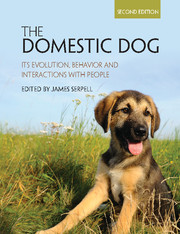Book contents
- Frontmatter
- Dedication
- Contents
- List of contributors
- 1 Introduction
- PART I ORIGINS AND EVOLUTION
- 2 Origins of the dog: The archaeological evidence
- 3 Origins of the dog: Genetic insights into dog domestication
- 4 Evolution of working dogs
- PART II BEHAVIOR, COGNITION AND TRAINING
- PART III DOG-HUMAN INTERACTIONS
- PART IV LIFE ON THE MARGINS
- Index
- Plate section
- References
4 - Evolution of working dogs
from PART I - ORIGINS AND EVOLUTION
Published online by Cambridge University Press: 30 December 2016
- Frontmatter
- Dedication
- Contents
- List of contributors
- 1 Introduction
- PART I ORIGINS AND EVOLUTION
- 2 Origins of the dog: The archaeological evidence
- 3 Origins of the dog: Genetic insights into dog domestication
- 4 Evolution of working dogs
- PART II BEHAVIOR, COGNITION AND TRAINING
- PART III DOG-HUMAN INTERACTIONS
- PART IV LIFE ON THE MARGINS
- Index
- Plate section
- References
Summary
Introduction
When we think of dogs, we tend to think of animals that were selected for behavior performed in the service of people. Dogs pull sleds, guard property, herd sheep, guide the blind, track and retrieve game, and so on. We also think of dogs in terms of breeds, and often try to identify the breeds that make up some mongrel, as if all dogs had unadulterated, purebred ancestry. Many see their favorite breed woven into the Bayeux Tapestry or carved into the walls of an ancient tomb. Some think of breeds as if they were ancient species, separately derived from different strains of wolves, jackals or even coyotes. And people are often amazed at the many different sizes, colors, shapes, faces, and behaviors dogs come in.
Dogs’ practical service to people is frequently overstated. Of the billion or so dogs in the world, only a tiny percentage of them work or hunt. Pure breeds of dogs for the most part are modern inventions (Larson et al., 2012).
Frequently it is stated that the breeds were “selected” to perform some specific behavior, implying that changes have come about through a gradual accumulation of traits, by a process similar to natural selection. Darwin (1858) used domestic animals as an example of “artificial” selection analogous to natural selection. However, discoveries in the last hundred years have suggested other evolutionary mechanisms underlying the morphological and behavioral conformation of domesticated animals.
This chapter distils our observations and experiments on the subject of breed-specific behavior. It is divided into two sections. Section 4.2 focuses on the functional morphology and behavior of three “types” of working dogs. First are the livestock guarding dogs, which evolved in pastoral societies, where the only selection by humans is for behavior designed to repel or eliminate animals they don't like. Second are the sled dogs, which are bred to pull. Any animal can be taught to pull, but in sled dogs there is intense selection for a superior conformation that can efficiently perform the task. Third are the livestock herding dogs, bred to conduct livestock. There is little selection for physical conformation in herding dogs, but rather intense selection for a behavioral conformation including attention to the quality, frequency, and sequencing of specific motor patterns.
- Type
- Chapter
- Information
- The Domestic DogIts Evolution, Behavior and Interactions with People, pp. 42 - 66Publisher: Cambridge University PressPrint publication year: 2016
References
- 19
- Cited by

